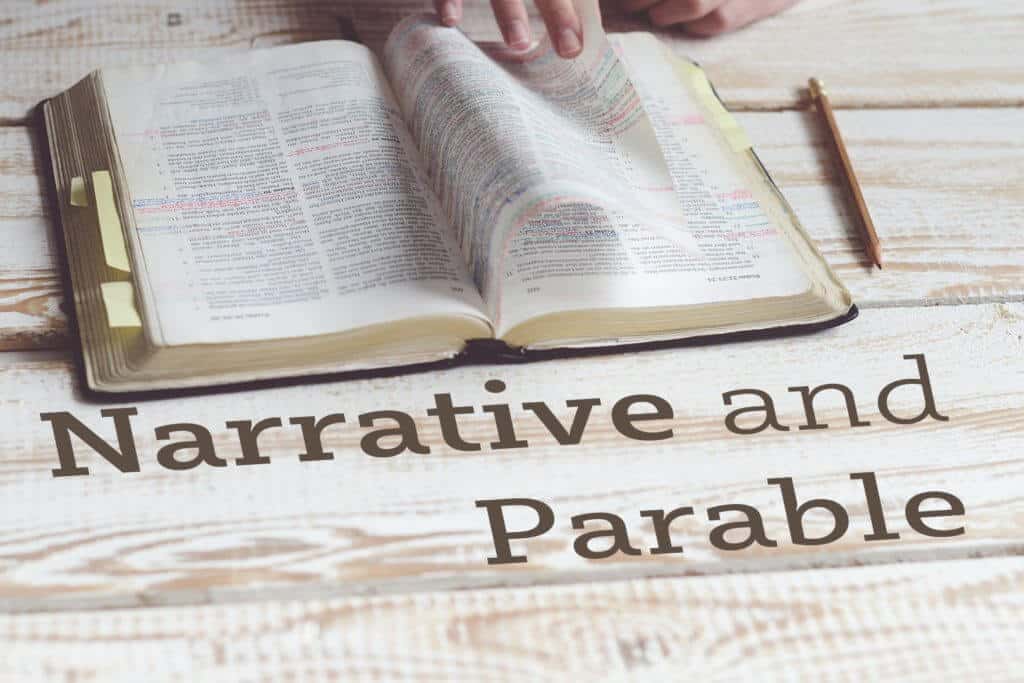[et_pb_section bb_built=”1″][et_pb_row][et_pb_column type=”4_4″][et_pb_text _builder_version=”3.0.67″ background_layout=”light” text_orientation=”left” border_style=”solid”]
Frequently in my Old Testament classes I discuss the tendency of modern, critical commentators to argue that the creation account of Genesis chapter 1 does not present an actual account of the creation of the world. Rather, many critical scholars argue that the creation account is in fact a fictional account that is designed to present the greatness of God. In response to this claim I argue that, if the creation account is fictional, then it does not in fact depict the greatness of God since the fictional account does not tell us any actual acts of God. In response to my charge against the critical interpretations, some have asked how this differs from the parables of Jesus. Since a parable does not depict any actual events or persons, then in like manner it does not inform us about anything in the real world.
Genre
Hebrew Poetry
First of all we must recognize the different literary genres employed in the creation account and in the parables of Jesus. The creation account presents itself a narrative. The creation account does not have the characteristics of Hebrew poetry. Hebrew poetry is characterized by short lines of text employing parallelism between the parts of the line and/or between lines in the poem. This is illustrated in the Amos 8:10 quote below.¹
[/et_pb_text][et_pb_image admin_label=”Amos 8:10″ _builder_version=”3.0.67″ src=”https://www.staging.ses.edu/wp-content/uploads/2017/12/Creation-and-Parables-1.jpg” show_in_lightbox=”off” url_new_window=”off” use_overlay=”off” sticky=”off” align=”left” always_center_on_mobile=”on” border_style=”solid” force_fullwidth=”off” /][et_pb_text _builder_version=”3.0.67″ background_layout=”light” text_orientation=”left” border_style=”solid”]
The chart above is an example of a line of Hebrew poetry and the correspondence that sometimes exists between the two parts of the line. The example is designed to show that Hebrew poetry is characterized by short lines. It is not meant to indicate that parallelism is characterized by a balance between these parts.
Narrative
Narrative literature is quite different from poetry. Narrative text is primarily concerned with relating a story in a straightforward manner. As Shimon Bar-Efrat puts it, “The narrative books of the Bible are not mere compilations of unconnected stories but, as is well-known, are made up of sequences of narratives, which combine to constitute wider structures.”² Interpreting narrative involves looking for the beginning and ending of the story. This can be done by finding the protagonist and the antagonist. The protagonist is not necessarily the “good guy.” The protagonist is the main character in the story. The antagonist is not necessarily the “bad guy.” The antagonist is something or someone who is contrasted against the protagonist. The antagonist can be a person or the environment. 
Also, the interpreter must discover the plot of the story. The Plot Structure: There are several types of plot structures. Although most stories revolve around some kind of conflict that must be resolved, the graphic in Figure 2 illustrates only one type of plot structure that is built upon conflict.³ Conflict may be psychological or physical as, in the case of David and Goliath. The conflict may be moral. The conflict is usually always spiritual. Is there suspense? Does the story build to a climax? Is the reader kept in the dark about some important data until the final scene? The conflict between Moses and Pharaoh is an example of a conflict that must be resolved.
One means of discovering a plot is to ask questions such as, What is the story about? What is the conflict that must be resolved? Other aspects to consider under plot include, What are the distinct parts of the story? What is the story line? What is the theme of the story? Also, look for the distinct parts that compose the story: Beginning: Where or when does the story begin? What does the beginning tell you? Middle: What are the details of the story. What happened? End: Is there a resolution? Does some aspect of the story lead into another story or act as the introduction of another story? There is, of course, much more to narrative than we can present here. The creation account seems to be a straight forward account of the events that took place and the things that were created. The graphic below sets out the text of Gen. 1:1–3 with a literal translation.
[/et_pb_text][et_pb_image admin_label=”Figure 3″ _builder_version=”3.0.67″ src=”https://www.staging.ses.edu/wp-content/uploads/2017/12/Creation-and-Parables-3.jpg” show_in_lightbox=”off” url_new_window=”off” use_overlay=”off” sticky=”off” align=”left” always_center_on_mobile=”on” border_style=”solid” force_fullwidth=”off” /][et_pb_text _builder_version=”3.0.67″ background_layout=”light” text_orientation=”left” border_style=”solid”]
Parables
A biblical parable is a short, simple story that is designed to illustrate moral and/or spiritual lessons. There has been no small debate on how to interpret parables. The current popular approach is that a parable has a single point or lesson to teach. However, there is hardly an interpretation of a parable in which a given interpreter’s “one point” conflicts with the “one point” of other interpreters. And, as Craig Blomberg points out, “Far from being an inferior art form, avoided by the master teacher, allegorical interpretation is an inevitable method of explaining the parables, which even those who deny it in theory cannot avoid in practice.”⁴ Nevertheless, most interpreters argue that allegorical interpretations of parables is not a legitimate method.
However, consider what Jesus said about interpreting parables:
¹⁰When he was alone, those around him with the twelve asked him about the parables. ¹¹He said to them, “The secret of the kingdom of God has been given to you. But to those outside, everything is in parables, ¹²so that although they look they may look but not see, and although they hear they may hear but not understand, so they may not repent and be forgiven.” ¹³He said to them, “Don’t you understand this parable? Then how will you understand any parable? ¹⁴The sower sows the word. ¹⁵These are the ones on the path where the word is sown: Whenever they hear, immediately Satan comes and snatches the word that was sown in them. ¹⁶These are the ones sown on rocky ground: As soon as they hear the word, they receive it with joy. ¹⁷But they have no root in themselves and do not endure. Then, when trouble or persecution comes because of the word, immediately they fall away. ¹⁸Others are the ones sown among thorns: They are those who hear the word, ¹⁹but worldly cares, the seductiveness of wealth, and the desire for other things come in and choke the word, and it produces nothing. ²⁰But these are the ones sown on good soil: They hear the word and receive it and bear fruit, one thirty times as much, one sixty, and one a hundred” (Mark 4:10–20).⁵
In this passage Jesus interprets the parable allegorically (see Table #1).
[/et_pb_text][et_pb_image _builder_version=”3.0.67″ src=”https://www.staging.ses.edu/wp-content/uploads/2017/12/table1.png” show_in_lightbox=”off” url_new_window=”off” use_overlay=”off” sticky=”off” align=”left” always_center_on_mobile=”on” border_style=”solid” force_fullwidth=”off” /][et_pb_text _builder_version=”3.0.67″ background_layout=”light” text_orientation=”left” border_style=”solid”]
The disciples begin to ask Jesus what the parable meant, and Jesus responds, “Do you not understand this parable? How will you understand all the parables?”⁶ Jesus says that if the disciples did not understand this parable, they would not be able to understand any of the parables. This indicates that the manner of interpretation of all the parables is the same as the interpretation of this particular parable, that is, allegorical.
Conclusion
No Evangelical interpreters, as far as I am aware, claim that the creation account is to be interpreted allegorically. But it seems clear that Jesus indicated that all the parables are to be interpreted allegorically. The parable of the sower and the soils is not designed to teach us anything about how to sow seeds. A parable is designed to illustrate facts in the real world. The parable of the prodical son is not teaching us about how to be a wise father and how not to be a good son. The parable is designed to teach us about facts in the real world. Blomberg gives some helpful observations about this parable:
In fact, the parable may just as easily subdivide into three rather than two episodes, one for each of the three main characters: verses 11–20a—the younger son’s departure and return; verses 20b–24—the father’s welcome; verses 25–32—the older son’s reaction.⁹ The most compelling resolution of the problem of the parable’s meaning therefore seems to be to affirm that it teaches three main points, one per character, and, in this case, one per episode. (1) Even as the prodigal always had the option of repenting and returning home, so also all sinners, however wicked, may confess their sins and turn to God in contrition. (2) Even as the father went to elaborate lengths to offer reconciliation to the prodigal, so also God offers all people, however undeserving, lavish forgiveness of sins if they are willing to accept it. (3) Even as the older brother should not have begrudged his brother’s reinstatement but rather rejoiced in it, so those who claim to be God’s people should be glad and not mad that he extends his grace even to the most undeserving.⁷
So, this parable is designed to illustrate that sinners must confess their sins and turn to God. Also, God offers forgiveness, and the attitude of the older brother illustrates how God’s people should rejoice in the forgiveness of God even given to the worst sinners. This parable is not about fathers and sons, but about God, sinners, and the people of God.
This is the distinction between the creation account and Jesus’ parables. The creation account is supposed to recount to the reader God’s creative activity. It is not a parable. The creation account does not have the characteristics of a parable. When critical scholars claim that the creation account is not actually a telling us about God actually creating the real world, but is a mythical/fictional account designed to illustrate God’s greatness. Since it does not depict any actual acts of God, it is not to be understood or interpreted as a real description of God’s real creative activity. If, however, the creation account is a fictional account, then it does not really tell us anything about God’s creativity or about God Himself.
Parables are fictional stories that are designed to teach lessons about the real world. Parables are not making claims about fathers and sons, or sowers and seeds. The creation account tells us about the real creative activity of God. The creation account depicts the creative activity of God in a straight forward manner. In the creation account God is the one who acts, and this is the content of the account. Parables are fictional, and they are not designed to teach us about the characters and actions of the persons in the parable. They are illustrative of real-world facts. So, even though parables are fictional accounts, they serve to illustrate rather than straight-forwardly describe. Also, as Jesus explained to the disciples that He would tell them about the kingdom of God in a straight forward manner, but to those outside, He would speak to them on in parables: “11He said to them, ‘The secrets of the kingdom of God has been given to you. But to those outside, everything is in parables, 12so that although they look, they will look but not see, and although they hear, they will hear but not understand, so that they will not repent and be forgiven” (Mk 4:11–12).⁸
The creation account is a straight-forward description of the real acts of God. God’s creative activity is the content of the story, so, if it is fictional, then it tells us nothing about God’s actual creative activity. This is the difference between the creation account and parables. When someone claims that the narrative accounts of the Old Testament are fictions, they have robbed the text of any significance because the text does not actually tell us anything that is real. Parables are fictional stories that are designed to illustrate some facts of the real world. Even though they are fictional, they do illustrate to us some truths of the real world. Parables illustrate truths about the real world. Narratives give an account of the truths about the real world.
[/et_pb_text][et_pb_divider _builder_version=”3.0.67″ show_divider=”on” color=”#0083ca” divider_style=”solid” divider_position=”top” divider_weight=”5″ hide_on_mobile=”on” saved_tabs=”all” /][et_pb_text _builder_version=”3.0.67″ background_layout=”light” text_orientation=”left” border_style=”solid”]
- In his book, The Idea of Biblical Poetry: Parallelism and its History, James Kugel has demonstrated that in terms of the form of a line of Hebrew poetry, parallelism does not always consist of a balance of stresses between the cola. In terms of form, many lines consist of cola that are unbalanced. According to Kugel, this indicates that parallelism of Hebrew poetic lines does not have as one of its characteristics a formal balance, and that the traditional explanations do not capture the function of parallelism. This debate is far too complex to do it justice here.
- Shimon Bar-Efrat, Narrative Art in the Bible (London: T. & T. Clark, 2008), 132.
- This graphic is taken from Yairah Amit, Reading Biblical Narratives: Literary Criticism and the Hebrew Bible, trans. Yael Lotan (Minneapolis: Fortress Press, 2001), Kindle Location 553.
- Craig L. Blomberg, Interpreting the Parables (Downers Grove, Illinois: InterVarsity Press, 1990), 41.


- Blomberg, Parables, 174.

[/et_pb_text][/et_pb_column][/et_pb_row][/et_pb_section]










